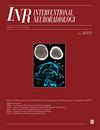血管内神经外科手术中的替代杂交入路:范围审查和技术考虑因素
IF 1.7
4区 医学
Q3 Medicine
引用次数: 0
摘要
背景股总动脉和桡动脉是当代血管内神经外科最常见的入路部位。有时,由于情况不同,可能无法安全到达血管靶点,因此需要采用其他方法。我们旨在回顾文献中描述的这些 "最后资源 "入路部位,重点关注技术方面,以方便参考。结果 在排除颈动脉直扎后,我们确定了九种血管内入路的替代方法:60 例患者采用颞浅动脉入路,5 例患者采用犊鼻孔入路,7 例患者采用枕动脉入路,6 例患者采用脑膜中动脉入路,23 例患者采用椎动脉入路,40 例患者采用颈外动脉、颌内动脉、面动脉或舌动脉入路。使用替代接入点的指征包括血管迂曲或闭塞、血管口径小或解剖变异。治疗的病症包括硬脑膜动静脉瘘、动静脉畸形、颅内动脉瘤、急性中风和颅内狭窄。结论替代血管通路扩大了手术医师的工具包,提高了处理复杂脑血管介入的能力。这篇综述主张更广泛地了解和考虑这些技术,因为它们有可能大大增加神经内血管手术的治疗选择。本文章由计算机程序翻译,如有差异,请以英文原文为准。
Alternative hybrid access in endovascular neurosurgery: Scoping review and technical considerations
BackgroundThe common femoral artery and radial artery constitute the most common access sites in contemporaneous endovascular neurosurgery. Oftentimes, it may be impossible to reach the vascular target safely due to different circumstances, necessitating alternative approaches. We aim to review these “last resource” access sites described in the literature, focusing on the technical aspects as a convenient reference.MethodsWe performed a comprehensive literature search of PubMed capturing articles from 1958 to 2022.ResultsWe identified nine alternative approaches for endovascular access, after excluding direct carotid stick: superficial temporal artery access in 60 patients, calvarial foramina access in five patients, occipital artery access in seven patients, middle meningeal artery access in six patients, vertebral artery access in 23 patients and external carotid artery, internal maxillary artery, facial artery or lingual artery in 40 patients. Indications for the use of alternative access points included tortuous or occluded vessels, small vessel calibers, or anatomic variation. Pathologies treated included dural arteriovenous fistulas, arteriovenous malformations, intracranial aneurysms, acute stroke, and intracranial stenosis. Diagnostic brain angiograms were also performed.ConclusionsAlternative vascular access routes expand the proceduralists' toolkit, enhancing the capability to manage complex cerebrovascular interventions. This review advocates for a broader understanding and consideration of these techniques, given their potential to significantly increase treatment options in neuroendovascular surgery.
求助全文
通过发布文献求助,成功后即可免费获取论文全文。
去求助
来源期刊
CiteScore
2.80
自引率
11.80%
发文量
192
审稿时长
6-12 weeks
期刊介绍:
Interventional Neuroradiology (INR) is a peer-reviewed clinical practice journal documenting the current state of interventional neuroradiology worldwide. INR publishes original clinical observations, descriptions of new techniques or procedures, case reports, and articles on the ethical and social aspects of related health care. Original research published in INR is related to the practice of interventional neuroradiology...

 求助内容:
求助内容: 应助结果提醒方式:
应助结果提醒方式:


